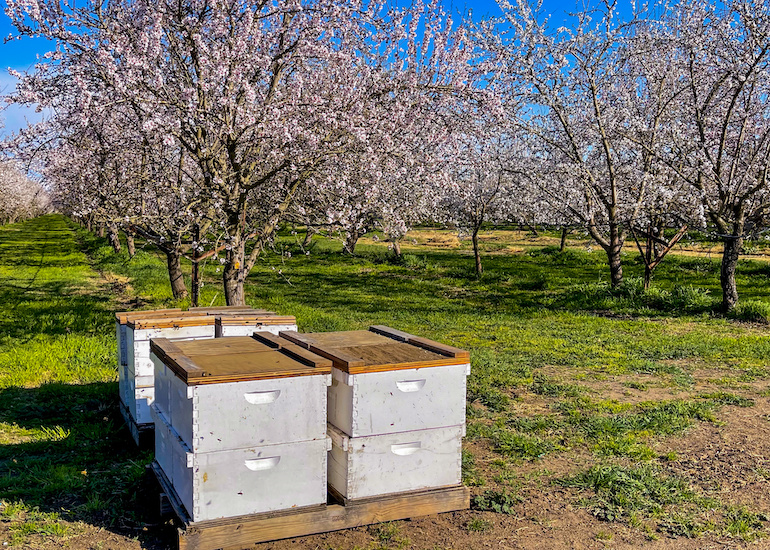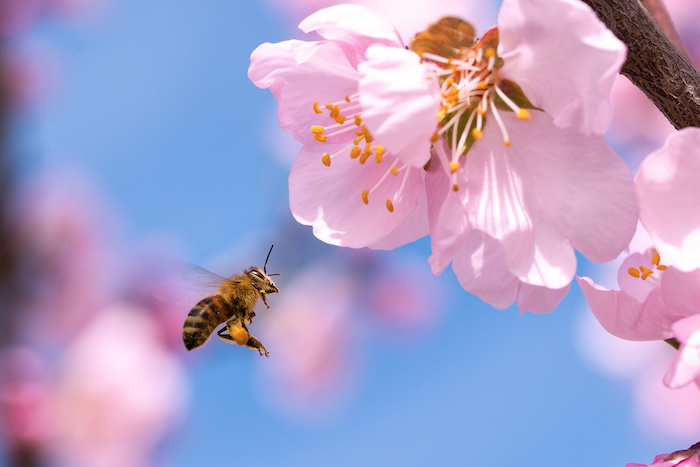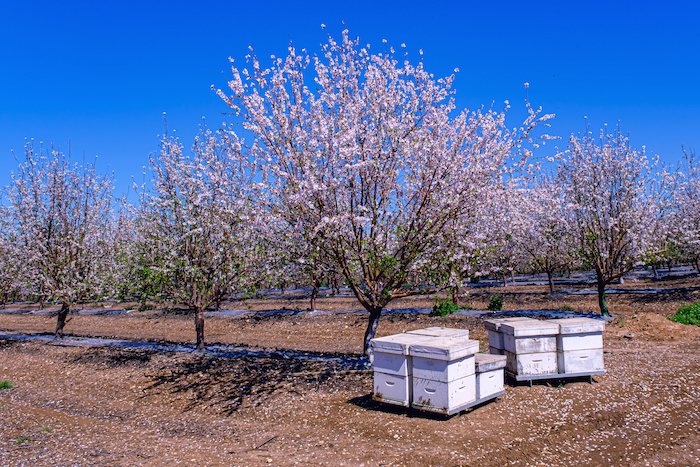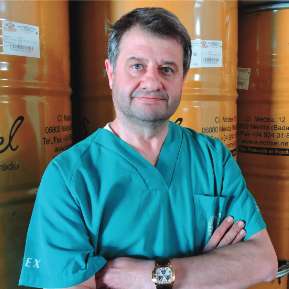When you think about pollination, what do you envision? A bee visiting a flower, moving pollen from the stamens of the flower to the pistil of the same, or in some cases, a different flower? I bet it seems like a pretty simple natural event.
In the early history of agriculture, feral (wild) bees and the few domesticated colonies a farmer might keep on his farm would be enough to pollinate the various crops that would come into season throughout the year. Small diverse farms have largely given way to commercial monocultural farms, which make it difficult for bees to effectively visit all the flowers in a large cultivated area.
With the arrival of the parasitic Varroa mite, many feral colonies have died off and farmers are finding there are just not enough available bees to pollinate the crop without supplementing the pollination by renting colonies. Hence the advent of commercial pollination: Farmers paying beekeepers to physically move their colonies to the target crop just in time to pollinate the bounty of flowers present. Doesn’t seem like such a simple event now, huh? Without this monumental effort by bees (and their keepers) saying crop yields would be less than optimum would be a massive understatement.
Before the arrival of Varroa mites, most commercial beekeepers in the United States made roughly two-thirds of their income from honey sales but after the arrival of Varroa, honey amounts to only about one-third of a beekeepers income, with commercial pollination contributing the remainder of the yearly income. Many factors have led to the increased demand for commercial pollination, but the biggest is a change in commercial agriculture with larger monocultural crops and a larger demand for these high-value crops.
About 35% of the world’s food crops depend on pollinators like bees, either directly or indirectly. Fruits, nuts, vegetables and seeds make up the majority of these essential nutritional crops. Without bees, many of these crops would see significantly reduced yields, impacting both food security and healthy nutrition.

While moving bees to pollination can be financially beneficial to the beekeeper, it doesn’t come without its drawbacks. Commercial beekeepers recognize that they lose roughly 3% of their queens every time they put colonies on a truck and move them long distances. So, for one round-trip to pollinate a crop and return to the home yard, queen losses can be 6% or higher. Other stresses on bees moved to pollination are brood stress, chill, relocation stress, robbing, fungicides and pesticides, diseases and mites.
When the bees are placed on a truck at night to be moved to a location for pollination, the bees will break cluster due to the movement and vibration. Breaking cluster causes much of the heat in the cluster to be lost, chilling the brood and putting additional stress the colony. In addition, the nurses will not be attending the brood as they normally would because of the disruption and vibration, thus further stressing the larvae. Once the colonies arrive at the new location it will take then several days for the colony to adjust to the new location, setting up foraging patterns for nectar, pollen and water. Hopefully the grower is aware of how sensitive bees are to fungicides and pesticides and restricts their use while the bees are in the orchard. After all why would a grower pay for pollination only to damage the ability of the bees to accomplish this job by putting out toxins and risking lower yields?
When bees are moved into intensive pollination situations there are often other bees present nearby from many different beekeepers. This can lead to the spread of diseases and parasitic mites. Weaker colonies will sometimes get robbed by stronger colonies and thereby spread mites and diseases. Because of the large amount of reorientation that occurs when bees are moved, we tend to see a lot of drifting of bees between colonies during pollination leading to the spread of mites and diseases. These are all things beekeepers have to consider when moving to commercial pollination.
When we talk commercial pollination, most people’s first thought is almonds, and for good reason. The pollination of almonds is the largest commercial pollination event in the world and it’s also one of the most difficult for the bees and the beekeeper.
Almonds are the earliest blooming commercial crop in the Northern Hemisphere with bloom beginning in late January and ending in March depending on the region. The fact that almonds bloom so early means there is little for the bees to forage prior to almond bloom, brood rearing will be minimal, and colony populations are still relatively weak due to the normal winter die-off of bees whose lifespan is coming to an end.
Research in the last 20 years has shown that stronger colonies do a better job of pollinating almonds because stronger colonies have more foragers to relegate to the field while still maintaining a strong brood nest with adequate nurse bees. Conversely, in a weaker colony, more bees have to remain in the hive to manage nursing duties, maintaining brood nest temperatures and others hive duties. For this reason, many beekeepers will feed their colonies sugar syrup and a protein supplement prior to almond pollination.
By stimulative feeding six weeks prior to moving to almonds, the colonies will have the opportunity to raise two rounds of brood thus boosting the colony population and providing a healthy nurse bee population. Early research done at the University of California Davis in the 1970s demonstrated that the best pollination of large almonds orchards was done by colonies with an average of eight frames of bees and not less than six frames of bees. A frame of bees is considered to be a frame at least two-thirds covered by bees on both sides of the frame. Many growers hire honey bee colony inspectors to quantify the populations of bees in the colonies and compensate the beekeepers by paying a base fee and a small bonus if colonies are larger than the agreed upon minimum.

Almond pollen and nectar are very good for bees. It is a complete protein and carbohydrate source. In 2012, a USDA researcher, Dr. Frank Eischen, collected almond pollen during bloom, stored it and fed it back to bees in an isolated research area of Texas. This was the only protein source the bees had for three months. The bees thrived on a monocultural diet of almond pollen with no apparent drawbacks. So once you get your colonies strong and ready for almond pollination, that should be the only supplementation you will have to do unlike other monocultural crops like blueberries or many vine crops like pumpkins, squash and cucumbers that nutritionally stress the colonies.

Because almonds are such a good crop for bees and almond bloom ends in early spring, the beekeeper may need to consider splitting (dividing) the colony soon after moving out of almonds. The only time I have not seen bees come out of almonds healthier than they went in is when the stocking rates were too high and there was not enough of the nectar and pollen resource to share between all the colonies. In the United States, the recommended stocking rates is 2 colonies per acre with an average of eight frames of bees per colony. That would equate to roughly 5 colonies per hectare. More colonies than that per hectare risks dividing the resource too much and the colonies cannot build population successfully.
To find out more, Project Apis m. has produced a video showing bees being transported to pollinate almond trees in California: Watch the video
—
I hope this has provided helpful insights into commercial pollination and the importance of bees to an ever-growing pollination industry!
Gordon
Gordon is the founder of MegaBee, a leading honey bee health company. Known as Dr. Wardell or Gordy, he has held several key roles in the industry. He has served as the chairman of the US-based non-profit Project Apis M., director of pollination for California’s Wonderful Orchards, and extension apiculturalist at the University of Maryland.
 by Antonio Pajuelo
by Antonio Pajuelo  by Jose Antonio Babiano
by Jose Antonio Babiano